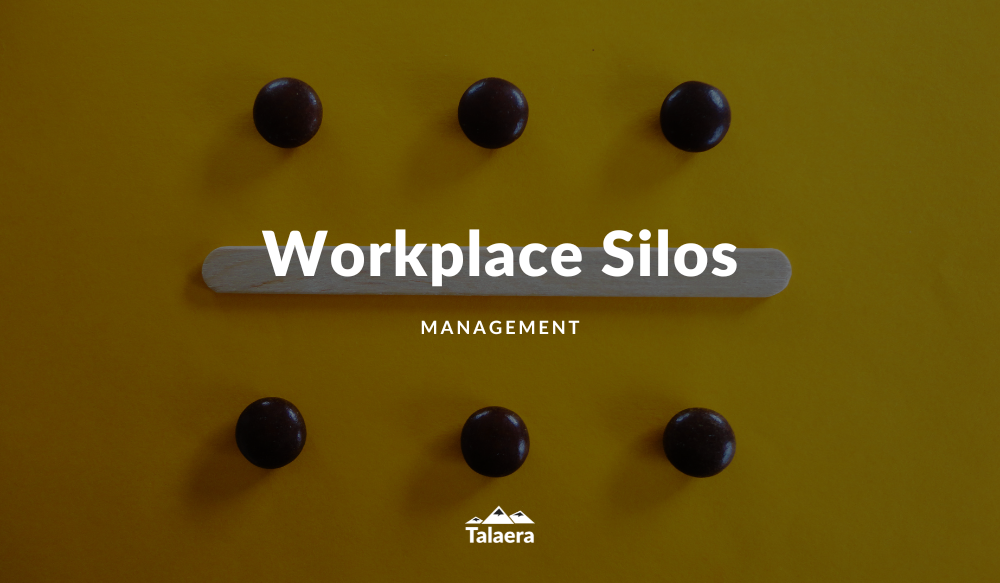By Paola Pascual on Sep 8, 2022 11:17:16 AM
An organization can't be agile and siloed at the same time. Workplace silos ruin trust, hinder collaboration, and cost money.
Yet only 19% of employees in the U.S. report that they’re satisfied with cooperation between their department and others, according to recent Gallup research.
And a Slack Future of Work Study found that nearly one in four workers (24%) in the U.S. are dissatisfied with communication at work, including how information is shared.
The good news? There are best practices you can implement in your organization to break down workplace silos that will help you build and empower cross-functional teams. In this article, we'll show you thirteen ways to do just that.
What are silos in the workplace?
Silo definition

The term "silo" traditionally refers to a tall tower used in agriculture to store grain. These cylindrical structures can also store other bulk materials, such as wood or concrete.
These silos were usually sealed to exclude air and better preserve the materials within.
Workplace silos definition

Workplace silos are isolated groups or departments that function independently and avoid sharing information with others.
Organizational silos happen when a company has groups of experts separated by department, division, or location. The problem arises when those experts are not just separated geographically, but when they work towards individual goals and forget about company goals.
If the information cannot be shared across your organization because of software limitations, you may also be suffering from organizational silos.
Farm silos and workplace silos are alike in the sense that they isolate their contents. What happens inside is protected from outside agents.
While this works very well to preserve materials, it doesn’t work so well with information. A silo mentality can be detrimental to your organization.
How do silos generally form?
- Individual mentality. Silos form when individual teams or departments lose sight of the organization's general mission and instead focus on their own individual goals. bigger picture, losing focus of company goals.
- Misaligned priorities. It may not just be a matter of mentality, but a friction when it comes to determining priorities (as an organization and as individual departments).
- Competing for resources. Workplace silos are also created when departments need to fight for resources. They fail to see the bigger picture and the environment becomes competitive.
- Communication issues. When there aren't clear channels of communication, a lack of a unified knowledge hub, and/or individuals lack the language ability to speak up and share ideas, silos tend to form. Also, as we develop specialized knowledge and language, we risk losing the ability to engage in strategic conversations and understand each other’s viewpoints, interests, perspectives, and practices.
- Cross-cultural clashes. In multicultural organizations or cross-border teams, part of the issue may be due to cultural barriers, assumptions, and stereotypes.
- Poor leadership. It starts, and ultimately ends, at the top. A common poor leadership practice is to prescribe what others should do but not modeling that behavior.
What is the cost of operational silos?

Operational silos can be remarkably costly for businesses. If your teams work in isolation, your business will suffer.
Organizational silos often lead to inefficiency, duplicated efforts, wasted resources, missed opportunities, and even conflict.
Getting people with different agendas to work together is one of the biggest obstacles that organizations currently face, according to the American Management Association's 2003 Survey on Leadership Challenges.
A recently commissioned study conducted by Forrester Consulting on behalf of Starmind found that many employees struggle to access the information they need to do their jobs effectively.
As a result, valuable time and resources are being wasted every day.
Decreased innovation and creativity
Operational silos can easily hamper innovation and creativity. When employees are not collaborating, they may not be able to share ideas and come up with new solutions.
Silos can limit your organization's ability to adapt to change, respond to new challenges, and grow.
Too much time wasted looking for solutions
Two-thirds of those surveyed for the Forrester study said that they spend too much time looking for the right people to help them.
When your employees struggle to find the information they need to do their jobs, productivity suffers greatly.
Every minute an employee spends searching for relevant answers is time they could be spending adding value. And if your organization has thousands of workers, the productivity losses could be worth millions of dollars a year.
Poor decision making
If your employees cannot easily access the most up-to-date information, how can they make good and effective decisions?
With key information missing, they will resort to making decisions based on assumptions and gut instinct.
Your organization will need to spend additional resources getting things back on track when poor decision-making leads to internal issues and damaged customer relationships.
Disengaged employees
Workplace silos are not only bad for business. They also make your employees' lives worse. Unhealthy relationships between groups may develop, frustration of wasting time may rise, and a disconnection from the mission will likely happen.
If your teams suffer the consequences of workplace silos, they will get frustrated and become increasingly disengaged.
What are some signs of workplace silos?

If you've ever played the telephone game, you know that messages can get garbled when they're passed from person to person. Workplace silos are like that, but on a larger scale. When information is passed along between departments that don't communicate well, it can get distorted.
There are several signs that may indicate your organization is siloed.
- Lack of communication between departments or divisions.
- Lack of collaboration on projects or initiatives.
- Duplicated work.
- Departments or divisions with goals and objectives that are not aligned with the organization as a whole.
- Feeling of mistrust or competition between departments.
If you have experienced any of the indicators above, it's time for your organization to take steps to break down silos and improve communication.
What are the benefits of taking down silos in the workplace?

There are many benefits to taking down silos in the workplace. When you break down silos, communication between departments and employees improves.
Your business will experience increased collaboration and creativity, as well as better problem-solving. Additionally, breaking down silos can help to improve morale and build a sense of team spirit in the workplace.
Another benefit of removing silos in the workplace improved efficiency.
When employees are able to communicate freely with each other, they can share ideas and resources more easily. This can help to eliminate duplication of effort and make the best use of everyone’s time.
Harvard’s Heidi Gardner also found that organizations with more cross-boundary collaboration achieve greater customer loyalty and higher margins.
13 Ways to Break Down Silos and Make Collaboration Happen

1.) Define the problem.
Before you can start to break down silos, you need to identify the problem. Is there a lack of communication between departments? Do team members not understand each other's roles? Are your teams struggling with cross-cultural communication? Do your international employees need support to communicate more effectively in English?
2.) Communicate a unified vision
In order to break down workplace silos, it is important to communicate a unified vision. All members of the team should be aware of the company's goals and how their work fits into the larger picture.
Include your employees in the decision-making. Create a vision together. Then, overcommunicate this vision that the entire organization.
If all everone is working towards a share vision, team members will be more likely to collaborate and support one another. It will build greater trust between teams, and help them adopt a big-picture approach.
3.) Set common goals
It is fairly common for your different teams to set goals that benefit their respective departments. Sometimes, those goals may even clash with another team's goals.
One of the best ways to break down silos in the workplace is to establish common goals. When everyone is working towards the same goal, it can help to create a sense of unity and cooperation.
Sit down with everyone involved and establish some common goals that everyone can work towards.
Employees will be more likely to communicate with each other and share information if they know that it will help to achieve the common goal.
4.) Bring teams and departments together
There are a few different ways that you can bring teams and departments together in order to break down workplace silos.
First, you can create opportunities for team members to work together on projects. Encourage cross-departmental collaboration on projects and initiatives. This will help them to get to know each other and build trust.
Encourage employees to socialize with each other outside of work. This will help them to build relationships and better understand each other.
By creating opportunities for teamwork, holding regular meetings, and encouraging employees to socialize with each other, you can break down workplace silos and improve communication between departments.
Finally, make sure that everyone is on the same page when it comes to deadlines and expectations. Effective communication will help to ensure that everyone is working towards the same goal. By breaking down silos, you will contribute to more effective and efficient cross-functional communication.
5.) Foster psychological safety
“What makes a Google team effective?” Research by Google and others found that the best performing team didn’t deliver because of talent, resources, or money. Out of 250 factors that were examined, the common denominator for outstanding teams was psychological safety. Those that lacked it, didn’t do so well.
Psychological safety happens when your team members feel safe to take risks and be vulnerable in front of each other.
Low levels of psychological safety contribute to a workplace where competitiveness dominates and silos are created.
Invest time in creating an enviroment where employees feel comfortable communicating openly, where they can't speak up without fearing negative consequences.
There are some quick but effective ways to increase psychological safety in your workplace. Start by letting them know that you are (truly) listening to them. Ask follow up questions and involve them in different decision-making processes. Avoid negativity and blaming, and establish a culture of feedback, where it is welcomed and not feared.
6.) Encourage open communication and idea sharing
One of the best ways to break down organizational silos is to encourage open communication and idea sharing.
When employees are not communicating effectively, it can lead to errors and misunderstandings. This can result in delays, rework, and lost productivity. In the worst cases, it can even lead to accidents.
Foster open communication by creating an environment where employees feel comfortable sharing their ideas with others. Encouraging employees to share their ideas openly will help to create a more cohesive workplace.
It is also important to encourage open communication between employees, not only between departments. Encourage employees to share ideas and information freely. Create an environment where it is okay to ask questions and challenge ideas. This will help to break down barriers between employees and departments.
Another way to break down workplace silos is to hold regular meetings and set up channels where team members from different departments can share information and ideas.
These meetings should be used to discuss various topics, such as goals, objectives, and projects. Having regular team meetings will help to ensure that everyone is on the same page and working towards the same goal.
Finally, effective communication between management and employees is essential in breaking down workplace silos. Management should make sure that they are clear about their expectations and objectives. They should also be open to hearing feedback from employees. Effective communication will help to create a more cohesive workplace.
7.) Ensure effective communication
Create consistent channels for communication, where idea sharing is encouraged.
But it goes beyond that. It's not only about communicating openly and sharing ideas, but also about doing it effectively. Effective communication is about both actively listening and understanding others and conveying information efficiently, so that it is clear to others.
Improving communication skills is crucial whether your employees are native-English speakers or not. However, pay close attention to your international workforce, as they may be struggling to join the conversation.
8.) Inspire teams to ask better questions
"We must become better at asking and do less telling in a culture that overvalues telling." –Edgar H. Schein, Humble Inquiry
If there is an intersection between effective communication and psychological safety, asking good questions must live right there.
As MIT’s Edgar Schein explains in his book Humble Inquiry, questions are the secret to productive work relationships, but they must be driven by a genuine interest in understanding another’s view. A great step to breaking down silos is to learn (as an organization) how to ask better questions.
Questions can help to surface areas of disagreement and help team members to see different perspectives, as well as identify potential solutions to problems.
Multicultural teams often need to work out how to best collaborate with other members from different backgrounds. Asking good questions can also bring your diverse teams closer together.
9.) Get leaders on board
The role of leadership in supporting effective communication strategies and breaking down silos is critical.
Leaders need to set the tone for communication within the organization and ensure that employees feel comfortable communicating with one another. Model the behavior you want to see from your team.
Leaders can also help break down workplace silos by encouraging employees to share information and collaborate on projects.
Be genuinely curious. A study of more than 1,000 middle managers at a large bank that Harvard Business School Francesca Gino and others conducted showed that managers with high levels of curiosity were more likely to build networks that spanned disconnected parts of the company.
Schedule regular check-ins. Regular check-ins are a great way to keep everyone on track and make sure that everyone is still working towards the same goals. It's also a chance for team members to raise any concerns or issues they may be having.
10.) Increase Cultural Intelligence (CQ)
American communication in the workplace may clash with business etiquette in Germany. Assertive communication doesn't always come across as polite, especially when English is not your first language. Small talk questions may differ across cultures.
But that shouldn't be a problem. The issue is not the cultural differences, is what we do with them. Aim for general understanding and cultural synergy. If your workforce is culturally diverse, help them increase their Cultural Intelligence (CQ).
Employees with a high CQ are aware of and understand the differences between people from different cultures. They are able to adapt their communication style to suit different cultures. They are able to tolerate ambiguity and navigate situations where they don't have all the answers.
When your teams have a good understanding of different cultures, they will be able to communicate more effectively with people from all walks of life. This will help to break down barriers and build bridges between people from different backgrounds.
Watch our on-demand webinar Managing Across Cultures and learn how to increase your CQ.
11.) Implement effective training and coaching programs
Equip your employees with the tools and resources they need to succeed. This way, you can help them feel more connected to their work and less isolated from their colleagues.
If your international employees can't express their ideas effectively, offer them business English training.
Additionally, regular training and coaching drive performance and engagement, which can further reduce workplace silos.
Explore cross-training. Cross-training is when employees are trained in multiple areas so that they can help out in other departments if needed. This is a great way to break down silos because it encourages employees to think outside of their
12.) Incorporate collaboration tools
Incorporating collaboration tools into the workplace will help you break down silos. These tools can help employees to share information and work together on projects more effectively.
As a fully remote team, these are some of the tools that have helped us mitigate workplace siloes at Talaera:
- Video calls: Zoom, Microsoft Teams, Google Hangouts
- Written communication: Slack, email
- Employee surveys: Survicate
- Cloud-based documentation: Notion, Google Drive
- CRM software: Salesforce, Hubspot
- Project management tools: Monday.com, Trello
13.) Create a sense of connection
A recent report from The Starr Conspiracy and Blueboard shows that 77% of employees want to work at an organization where they feel connected to the purpose and the people, yet that same study shows that just 31% of HR professionals feel they’ve adequately addressed connection challenges at their organization.
This “Connection Gap” can be one of the reasons your teams are building silos. Look for the right programs that can help you address this urgent issue and break down silos in your organization.
Conclusion
The real problem isn’t the silos. The problem is the people within the silos and their silo mentality.
Completely breaking down silos in the workplace is oftentimes unrealistic. What matters is to break those barriers that the silo mentality created. Your goal as a leader is to be the glue that connects all the dots, bring your teams together, and make collaboration happen.
Watch this recent discussion on how to break down silos with experts from Talaera, Blueboard, and Bravely:
Business English training for your global teams
If you are willing to help your international employees improve their communication skills for the workplace, share our free communication resources with them. Distribute them internally and encourage them to make them part of their lifelong learning.
If you have identified actual communication issues or cultural clashes, get in touch with Talaera and we will advise you on the best programs for your teams.
For any additional information or questions, you can also reach out at hello@talaera.com. Interested in getting the best offers and receiving free content on Business English communication? Subscribe to our newsletter and we will keep you in the loop with offers, free events, and development materials!
If you enjoyed this article, keep reading:
- How To Manage Language and Cultural Diversity in The Workplace [Guide]
- How to Break Down Silos and Boost Collaboration [Webinar]
- 5 Great Ways To Practice Self-Care For HR Professionals
- How Delegating Will Help You Grow And How To Do It Effectively
- 4 Reasons You Should Be Building Trust In Your Employee Engagement Game
- How To Overcome The Top 4 Communication Barriers In The Workplace
- 10 Qualities Of A Good Leader In Today’s High Tech Industry
- To Recognize Employees, Appreciate Hard Work In 5 Simple Steps
- 9 Solid Reasons To Offer Remote Learning To Your Employee
- Diversity and inclusion
- Diversity Quotes to Inspire Your Teams




comments